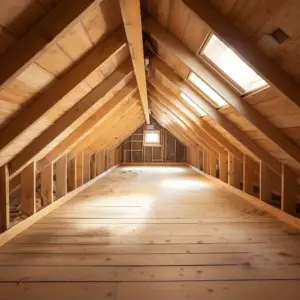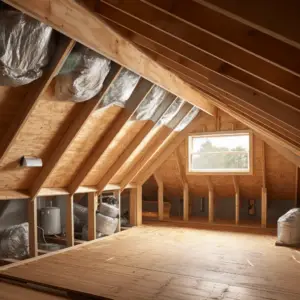Table of Contents
Importance of Attic Ventilation
Attic ventilation is essential for keeping your home in good shape. It lets air circulate, avoiding moisture buildup that can cause mold and mildew. Plus, it helps keep the attic temperature steady, which reduces the burden on your HVAC system and conserves energy.
A well-ventilated attic guards against many issues. Too much humidity creates the perfect environment for mold, which weakens your home and threatens your health. Ventilation helps prevent this, giving you and your family a healthier place to live.
Additionally, proper attic ventilation prolongs the life of your roof. In hot climates, heat can make shingles brittle and cause them to break down faster. Letting hot air out decreases thermal stress on the roof, making it last longer and saving you from replacing it sooner.
Pro Tip: Make sure intake and exhaust vents are balanced for best airflow in your attic. This will maximize the advantages of attic ventilation and keep your home in good condition.
Understanding the Basics of Attic Ventilation

Attic ventilation is key for a healthy, sustainable home. It regulates temperature and moisture, which prevents damage to the roof and mold growth.
Hot air escapes during warm weather, cooling the attic and lowering energy costs. In colder months, ventilation prevents moisture buildup which leads to mold growth.
Ancient Romans knew the importance of airflow and used hypocausts. These used small openings and ducts under floors to let hot air rise and escape through vents in the roof. It’s proof that proper ventilation has been important for centuries.
Benefits of Proper Attic Ventilation
Proper attic ventilation offers multiple benefits:
- Firstly, it regulates the temperature in the attic, stopping excessive heat build-up in summer months. This reduces strain on HVAC systems and lowers energy costs.
- Additionally, it stops moisture build-up which can cause mold and mildew growth. This helps preserve the attic’s structural integrity and prevents potential health hazards.
- Finally, proper attic ventilation boosts air quality by letting fresh air circulate, reducing pollutants and odors.
Plus, proper attic ventilation prolongs the lifespan of roofing materials such as shingles. It minimizes temperature fluctuations and moisture, thus reducing the risk of material degradation and boosting their durability.
A great tip: Balance intake and exhaust vents for optimal airflow. Consult professionals or use ventilation calculators to determine the right number and positioning of vents based on factors like attic size and climate conditions. From turbine vents to ridge vents, these attic ventilation systems provide better airflow than a politician trying to win an election!
Types of Attic Ventilation Systems
An attic ventilation system is essential for a healthy and energy-efficient home. Soffit and ridge vents, gable vents, powered attic fans, and turbine vents are all types of attic venting systems.
Soffit vents are intake vents located along the eaves of the roof, while ridge vents are exhaust vents at the peak of the roof. Gable vents provide cross-ventilation with fresh air entering from the lower portion and hot air escaping from the upper portion.
Powered attic fans are installed on the roof and can be controlled by thermostats or switches. Turbine vents spin when exposed to wind, creating suction that draws out hot air from the attic.
ENERGY STAR® recommends attic ventilation systems to reduce energy costs and prevent moisture-related issues. They are also necessary to avoid a haunted house!
Factors to Consider in Designing an Effective Attic Ventilation System
Designing an effective attic ventilation system involves various factors. It helps to keep temperature and humidity levels optimal, promoting a healthier living environment and avoiding potential issues such as mold growth and structural damage.
- Roof type: Consider the slope, material, and design of the roof when selecting a ventilation system.
- Attic size: Bigger attics need more ventilation for proper air circulation.
- Climate: Hot and humid climates require more ventilation than cold climates.
- Insulation: Proper insulation prevents heat transfer and maintains a consistent temperature.
- Ventilation types: Vents like ridge vents, gable vents, soffit vents, or turbines can be used, depending on the attic’s needs.
- Maintenance: Regular inspection and maintenance are a must for an effective ventilation system.
Extra considerations include trees or buildings near the attic and local building codes. To maximize the ventilation system’s effectiveness, balance intake and exhaust vents, install baffles or chutes along the eaves, and use high-quality materials for vent covers. By doing this, designers can create an effective attic ventilation system that circulates air, regulates temperature and moisture, and ensures a healthy living environment.
Common Issues with Attic Ventilation
Attics with poor ventilation are like sweatpants with no elastic waistband – they’re just not giving you enough breathing room. Proper attic ventilation is key for a healthy and efficient home.
However, some common issues can arise. Inadequate venting, blocked vents, improper vent placement, insufficient insulation, and uneven vent distribution can all disrupt airflow. It’s vital to address these quickly. Cleaning vents and adding insulation, plus consulting a professional, can help. Consider climate, materials, and the home design when choosing a solution.
Signs of Inadequate Attic Ventilation
Inadequate attic ventilation can cause lots of problems that need dealing with quickly. Here’s what to watch out for:
- Excessive heat: If your attic feels like an oven, it’s time to check your ventilation.
- Moisture: Stale air can cause condensation and mold. Look for damp patches or musty odors.
- Roof damage: Too much humidity and heat can damage roof shingles. Watch out for curling, cracking, or aging.
Apart from these signs, there are other issues. Poor ventilation can reduce energy efficiency. Hot air escapes, so your AC works less hard. That lowers energy costs.
To address inadequate ventilation, try these suggestions:
- Fit roof vents: Ridge vents and turbine vents can help hot air escape, cooling the attic.
- Install soffit vents: These bring in fresh air while roof vents expel hot air. This promotes good circulation.
- Get attic fans: These actively extract hot air during summer months when it’s hottest.
For a healthy home and long-lasting roof, proper attic ventilation is essential. Try these ideas and you’ll soon be breathing easy!
DIY Attic Ventilations Tips
Keep your attic fresh and dry with these DIY ventilation tips!
- Check for any blocked vents
- Install attic fans
- Use soffit vents
- Seal air leaks
- Add insulation
- Trim overhanging branches
Plus, get a programmable thermostat and a hygrometer to regulate temperature levels and monitor humidity. If you’re uncertain, it’s best to consult a professional. Don’t miss out on the benefits of proper attic ventilations – act now and create a healthier living space for you and your loved ones!
Professional Attic Ventilation Solutions
Attic ventilation? It’s essential for a healthy and comfy home. Professional solutions exist to ensure proper airflow and temperature control. Consider these:
- Ridge vents – along the roof ridge, to let out hot air.
- Soffit vents – under the eaves to draw in fresh air.
- Gable vents – on the gable ends to aid air exchange.
- Attic fans – electric-powered to exhaust hot air.
- Radiant barriers – reflective materials like foil insulation, to reduce heat transfer.
- Insulation – to regulate temperatures and reduce energy loss.
Weather conditions, attic size, and roofing materials also matter. Plus, attic ventilation can extend your roof’s lifespan – preventing moisture buildup and reducing heat-related damage. So, not only will it improve your comfort, but protect your home investment too!
The Cost of Installing Attic Ventilation Systems
Installing attic ventilations systems can be a worthwhile investment. They regulate temperatures and reduce moisture, plus increase a home’s energy efficiency! But, cost is important to consider. Here’s what impacts the cost:
- Type of system: $500 – $2,000.
- Size of attic: $0.50 – $3/sq. ft.
- Additional features: Vary.
The type of system chosen affects the cost. Also, larger attics require more material and labor. Extra features, like programmable thermostats or humidity sensors, can add to the cost, but provide extra control and efficiency.
For an accurate quote, talk to a professional who can assess your attic ventilation needs. Then, make an informed decision without breaking the bank. No ghosts in the attic, unless they pay rent and provide quality ventilation!
Maintaining and Inspecting Attic Ventilations

Checking and keeping an eye on your attic ventilation is essential for the overall health and efficiency of your home.
Here are five points to think about:
- Look out for any damage or blockages in the attic ventilation system. Check the vents, ducts, and fans for any blockages that stop the airflow.
- Keep insulation away from the vents. This can block air movement and cause bad ventilation. Insulate the attic, but be careful not to obstruct the venting process.
- Monitor the humidity levels in your attic. Too much humidity leads to mold and rotting wood. Too little humidity causes drying and potential damage. A humidistat can help regulate moisture.
- Seal any cracks or gaps in the attic that let outside air in or conditioned air out. Good insulation and weather stripping can help maintain ventilation.
- Contact a professional if you have persistent issues with your attic ventilation system. They can assess the situation and recommend effective solutions.
Moreover, proper attic ventilation not only makes your living space more comfortable, but also lengthens the life of your roof. Plus, if the attic is not properly ventilated, energy consumption can increase by up to 30%. (Source: U.S. Department of Energy)
Conclusion: The Importance of Proper Attic Ventilations
Attic ventilations is key for a healthy, energy-saving home. It helps circulation of air, stops moisture buildup and lowers the danger of mold and mildew. Additionally, it regulates temperature, preventing too much heat in summer and easing pressure on your HVAC system.
For ideal attic ventilations, you need both intake and exhaust vents. Intake vents usually sit along the soffit or eaves of your roof. They let fresh air into the attic. Exhaust vents are usually at the top of the roof. They let hot air out.
Insulation is important, too. If insulation isn’t enough, airflow will be blocked and ventilation won’t work well. You need insulation that lets in air movement while giving a thermal barrier.
Let’s look at Sarah. She had a musty smell in her home for months but couldn’t find it. She found out her attic didn’t have good ventilation. This caused moisture buildup and mold. With help from experts, she got good intake and exhaust vents, improving her home’s air quality.
Investing in attic ventilations makes your living space comfy and protects your home from damage caused by moisture problems. So take care of your attic now!